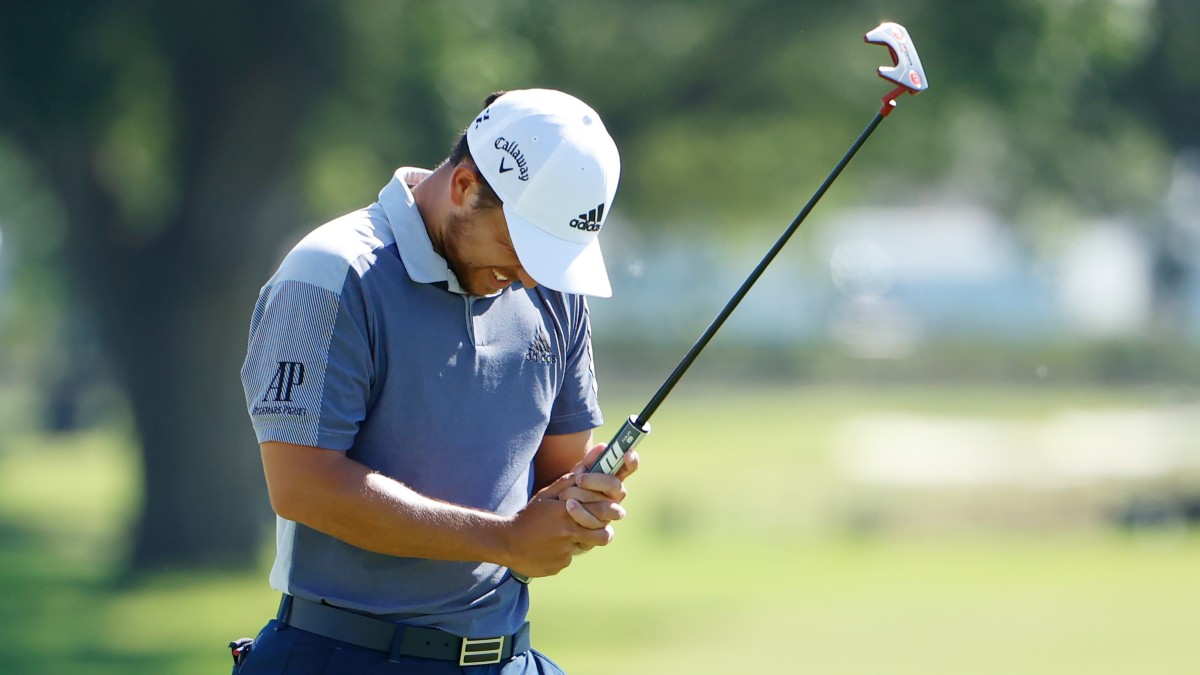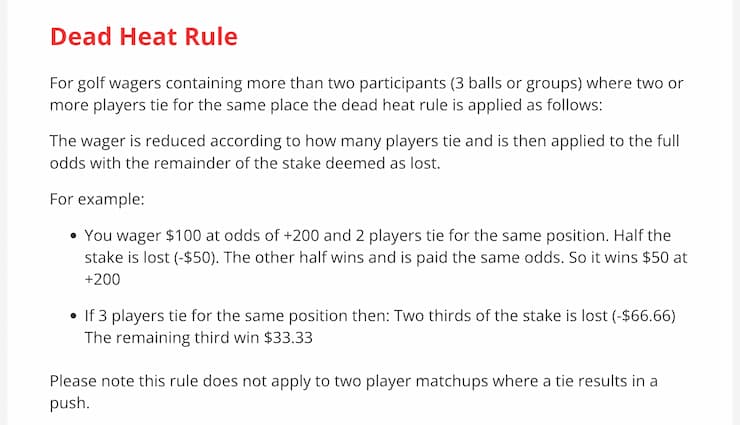What are dead heat rules in golf betting

Essentially, you divide your stake by the number of extra what are dead heat rules in golf betting. So your $ stake is divided by the 3 extra players who also finished tied. mtwarrenparkgolf.com.au › Sports Betting Guides. Dead Heat Rules decide how winnings will be calculated in the event of a tie. The easiest way to understand it is you essentially win part of your bet. The. A dead heat is when two or more participants finish in a tie and can't be separated. This includes a photo finish in horse racing, a tied.
How Do ‘Dead Heat’ Ties Work in Golf Betting?
MGM does not pay out in full for first-round leader bets. The tricky part on the surface is that the "ties" often go through T-5 or T — you may have five players tied for third at , and then the next player on the leaderboard finishes in eighth. Here are two examples from the Charles Schwab Challenge, covering several of those circumstances.
That's because there were only three spots for four tied players in the Top 5. It was essentially one extra player occupying the position you needed to cash your bet. Tenth-place at the Charles Schwab also had dead-heat rules apply, but because there was only one spot available for four tied players, your stake would take an even bigger hit than in the Top 5 example.
One of the most common dead heats — or the one bettors care about the most — is first round leaders. As we've touched on, most books will take half your bet amount, and then apply the same odds to the remainder of your bet. It works the same for 3-ball matchups. In a matchup with two golfers, a tie will just result in a push and your money back.
Zalatoris and Varner tied. At most sportsbooks, your stake will be cut by the number of tied golfers relative to the spots available. Some others will cut the odds. And there could be a big difference in money depending on the bet. MGM doesn't have dead-heat rules at all for bets like Top 20s, and will pay ties in full. PointsBet cuts the odds. Most others cut the stake.
Even if you're betting longshots, where the stake is small and the payout is large, you'd want to have the odds cut. Let's say Jason Kokrak is to finish Top 5, and he ties for fifth with two other players. What are dead heat rules in golf betting Of course, you'd rather have no dead heat applied at all.
So bet at MGM if you can. No dead heat is a tremendous advantage for bettors, assuming the prices are comparable to other books. It's really difficult to put exact math on it, but if the prices are far worse at a non-dead heat book, it's not worth the hopes of getting paid in full. Some of MGM's odds for finishing position are worse than the market, but others aren't.
Typically, dead heat books will offer slightly better odds overall, but that doesn't mean they'll have the best odds on every golfer. This site contains commercial content. We may be compensated for the links provided on this page. The content on this page is for informational purposes only. Action Network makes no representation or warranty as to the accuracy of the information given or the outcome of any game or event.
US Betting. Get App. Gambling Problem.  That's because the three-way option has more vig , which is advantageous for the sportsbook. BetMGM lists two players with a tie bet available and two players with a tie resulting in a refund right next to each other. Here's another Masters example. For the two-way market where the tie is refunded, the sportsbook margin is 4.
That's because the three-way option has more vig , which is advantageous for the sportsbook. BetMGM lists two players with a tie bet available and two players with a tie resulting in a refund right next to each other. Here's another Masters example. For the two-way market where the tie is refunded, the sportsbook margin is 4.
If you don't think the tie will come into play and want to bet your golfer at a slightly better price, go ahead. Just know that in the long run, it's disadvantageous because the sportsbook margin is higher. Three-ball matchups feature three players, with each usually at plus-money. That's because it's harder to beat two other players than one, so the probabilities are spread out across the three players.
Let's use a Round 1 3-ball example from the British Open. Sportsbooks use the actual tournament threesome pairings so that they can't get burned by the variables that come with different tee times, like weather or the course softening up later in the day. Much higher than the two-way matchup. If two or all three players tie, dead heat rules will apply at most sportsbooks, meaning your winnings will be cut by the number of players who tied.
There's a third type of matchup betting that features about five players who have roughly the same odds to win the tournament. It's often called "group betting. The golfer with the best score out of these five will win the group. But the hold is even higher than 3-ball betting — this group at bet has a Dead heat rules will also apply here, so if two players tie for the best score, your bet will be cut in half.
This site contains commercial content. We may be compensated for the links provided on this page. The content on this page is for informational purposes only. Action Network makes no representation or warranty as to the accuracy of the information given or the outcome of any game or event. US Betting. Get App. Gambling Problem?
Call New Users Only. Terms and Conditions Apply.
Popular Pages
- Betting gods golf reviews
- Vegas odds pga
- Rocket mortgage golf betting tips
- Tour championship betting odds
- Golf bets press
- Pga tournament odds this week
- Draft kings how long until golf bet settles
- Beating odds
- Wgc leaderboard 2023
- Golf lines
- Ladbrokes open golf betting
- Golf us masters
- Pari mutuel betting golf software
- Www golf 3 ball betting tomorrow
- How to bet on golf tournaments